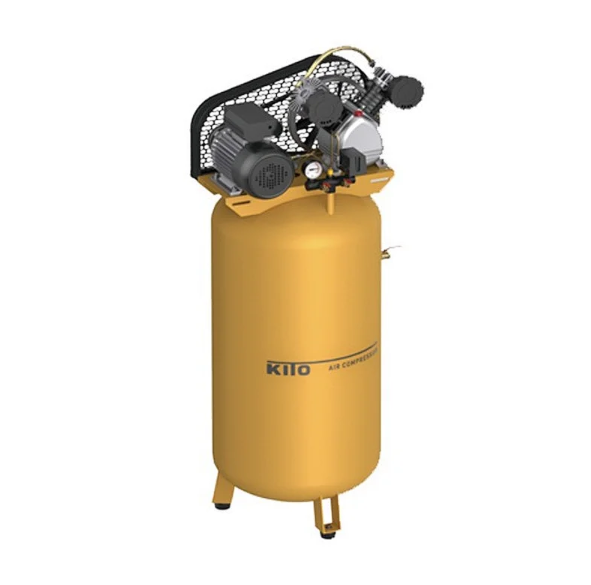Air compressors find application in numerous businesses and industries, serving a wide range of purposes, including vehicle body painting and food manufacturing. There are primarily two distinct types of air compressors: screw air compressors and piston air compressors. However, what sets these two apart from each other? Let’s introduce them first.
What is screw air compressor?
A screw compressor sucks in refrigerant through a toothed space formed by the meshing of a male rotor composed of 5 convex teeth (hereinafter referred to as the M rotor) and a female rotor composed of 6 concave teeth (hereinafter referred to as the F rotor), and compresses the refrigerant to a predetermined pressure by reducing the toothed space. The workflow of a screw compressor is as follows:
Suction stroke
Suck in refrigerant from the intake opening in the axial to radial direction. As the rotor rotates, on the lower side of the rotor, the meshing separates, the length of the tooth groove increases, and the refrigerant is sucked into the tooth space.
Compression stroke
Starting from the suction side of the tooth groove, the meshing of the tooth shape is carried out, and the sealing line gradually moves towards the discharge side, reducing the space of the tooth shape and compressing it.
Compression stroke
By inhaling lubricating oil along with the refrigerant, an oil film seal is formed in the rotor gap, while lubricating the rotor. The positive and negative rotors gradually approach the discharge port for compression, resulting in an increase in pressure.
Discharge stroke
Connect the tooth space to the discharge port and start the discharge stroke. This journey continues until the discharge end, until the refrigerant in the toothed space is completely sent out.
What is piston type air compressor?
When the crankshaft of a piston air compressor / reciprocating air compressor rotates, the piston undergoes reciprocating motion through the transmission of the connecting rod, and the working volume composed of the cylinder inner wall, cylinder head, and piston top surface undergoes periodic changes.
When the piston of a piston compressor starts to move from the cylinder head, the working volume inside the cylinder gradually increases. At this time, gas moves along the intake pipe, pushes open the intake valve, and enters the cylinder until the working volume reaches its maximum, and the intake valve closes; When the piston of a piston compressor moves in the opposite direction, the working volume inside the cylinder decreases and the gas pressure increases.
When the pressure inside the cylinder reaches and is slightly higher than the exhaust pressure, the exhaust valve opens and the gas is discharged from the cylinder until the piston moves to its limit position, and the exhaust valve closes. When the piston of the piston compressor moves in reverse again, the above process repeats.
In short, the crankshaft of a piston compressor rotates once, the piston reciprocates once, and the cylinder undergoes the processes of intake, compression, and exhaust, completing a working cycle.

What is the Difference?
The primary distinction between a screw compressor and a piston (reciprocating) compressor lies in their compression mechanisms. Screw compressors employ two interlocking helical screws, whereas piston air compressors rely on pistons driven by a crankshaft. Additionally, there are notable differences in the number of moving parts between these two types of compressors. Screw compressors have only two moving parts that do not come into contact, whereas piston compressors involve a more complex assembly with multiple moving parts.
Moreover, screw compressors tend to operate at lower temperatures, thanks in part to their efficient cooling systems. These qualities make screw compressors particularly well suited for heavy duty industrial applications.
Another difference is the moving parts as the screw compressor has two moving parts which are not in contact while the piston compressor has a lot of moving parts. The screw compressors operate at a lower temperature and integrate a good cooling system.
ZHEJIANG KITO supply high cost effective silent air compressor, regarding “ultra quiet “ as destiny optimizing and adjusting the process of production, implementing QC system, and promoting the upgrading and manufacturing of high quality air compressors actively. KITO is looking forward your contact of high pressure belt driven piston type air compressor industrial / building use!